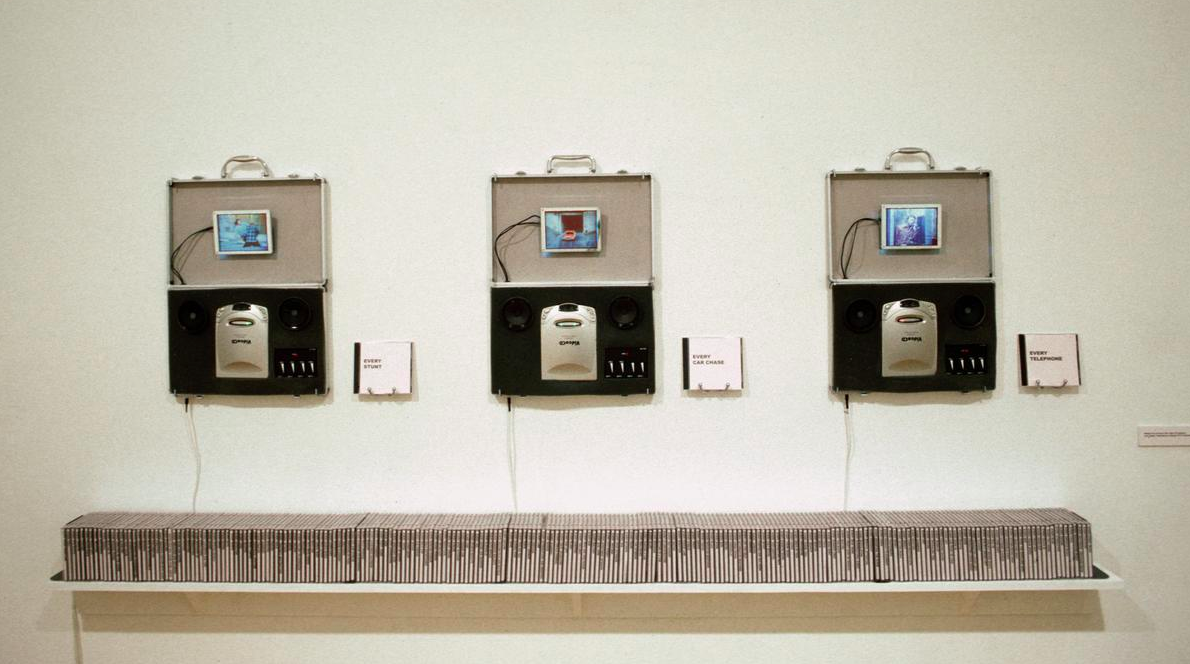Every Shot, Every Episode
Every Shot, Every Episode, created by Jennifer and Kevin McCoy, is an installation art that breaks down the shots and sequences of 20 episodes from the 1970’s cop show Starsky and Hutch. The McCoys develop an archive of snippets from the show to illustrate cultural expression in a modern sphere through highlighting the manner in which the computer age meets the database. With the proliferation of images in modern culture media art, the database serves as a tool to confront the themes viewed in a fictitious cop show that are continuously present in our society. The piece is a collection of individual items serving no beginning or end, no development, nor any narrative. Each individual item possesses equal significance through the presentation. Jennifer and Kevin McCoy extracted each episode by hand, watching and cutting the episodes to formulate categorized themes. The individual items are categorized into 300 varied elements: structural format, visuals, stock character/narrative, action, and so on. The shots from Starsky and Hutch are pulled apart, catalogued, and sequenced into a category. Examples of these categories are: “every zoom in,” “every car chase,” “every alcoholic,” “every insult,” “every office,” to 300 total “every” pieces.
This extraction of pieces from different scenes is reminiscent of Christian Marclay’s The Clock. Marclay developed a series of digital video clips that presents 1000 movie scenes showing a clock or discussion of time while the installation is in sync with real time. Through this showing, the viewer is able to meditate on time as time is passing and is thematically exhibited to delve into the concept and notions of time. This piece relates to Every Shot, Every Episode through the process of development by the artists.
Image courtesy of http://www.edrants.com/christian-marclays-the-clock/
As a 1970’s television show, each episode elicited the same visual and plot elements, not only to every other episode of Starsky and Hutch, but too to the outlines of all other 1970’s shows. Through this technique of separating out the episodes, the McCoys create a collection of each critical aspect that is included in every episode to ultimately hold the ammunition needed to develop the perfect episode - an episode that contains all of these 300 categorical elements compacted in one. When each episode is pulled out from the story line, what truths become exposed when the narrative is disrupted? What does the audience understand of the T.V. show? Will audiences understand the storyline of Starsky and Hutch? 70’s television shows altogether? Or will they simply view how white American men choose to deal with the world? The McCoy’s challenge the untold secrets of storylines of making a perfect show by disrupting the narrative. Through these hand-made cuts and categorical creations, audiences are fixated on creating their own interpretation of the narrative.
Jennifer and Kevin Mccoy continue to push the sensibility of the context of the world in which we find ourselves involved in through the installation series Soft Rains. Soft Rains extracts different representations of genres from varying time periods of film and stitches the film together. The stitching of videos fabricates a different story based on place and time of viewing. This digital construction disrupts the narratives of the horror films into a fanatical world, as does Every Shot, Every Episode.
Image courtesy of http://archief.z33.be/en/artists/jennifer-kevin-mccoy
Having a formulaic episode at one’s dispense, however, would be all too easy. The viewing materials are stationed in a briefcase, a prop used by the cop detectives to contain secret information. The video cd player and the screen are displayed in an open lower and upper half of the briefcase, respectively, in the installation. The collection of cds labeled with their specific element are displayed next to the briefcase. Upon viewing the information within one cd, one must place the cd into the video cd player situated in the briefcase. This action serves to elicit top-secret information -- information which Hollywood deems unworthy of sharing with the public. The contained evidence, so to speak, will not allow viewers to actually see the secrets of creating a perfect episode, such that if Hollywood does have one, it would be locked up in a briefcase. With this, television shows simply continue to use the same formula when creating shows, and thus, Every Shot, Every Episode is simply a presentation of each cinematic output that is recurrent in following episodes.
Exhibitions:
Stop Motion, 2006, Edith Russ Haus for Media Art
Pop_Remix, 2004, S.F. Cameraworks
Learning to Watch, 2004, Sala Rekalde
Robot Films, 2003, FACT Centre
Watery, Domestic, 2002, The Renaissance Society, Chicago, IL
Love and Terror, 2002, Butler Art Institute
We Like to Watch, 2002, Postmasters Gallery, New York, NY
We Like to Watch, 2002, Van Laere Contemporary Art Gallery,
Special Exhibition, 2004, Metropolitan Museum of Art
New Acquisitions, 2002, Metropolitan Museum of Art
Technically Engaged, 2001, A.I.R. Gallery
Links:







